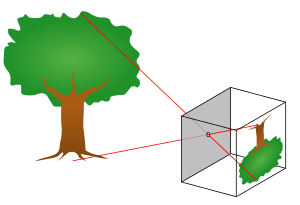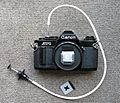Pinhole camera facts for kids
A pinhole camera is a special kind of camera. It does not use a normal glass lens. Instead, it has a very tiny hole in a thin piece of material. This small hole lets light from a scene pass through just one point. This creates an image on the other side.
For the image to be clear, the hole (called the aperture) must be very small. It should be about 1/100th of the distance to the screen where the image appears. The camera's shutter is usually a simple flap. This flap is moved by hand to cover and uncover the tiny hole. This controls when light enters the camera.
Pinhole cameras need much longer exposure times than regular cameras. This is because their hole is so small. Typical exposure times can be from a few seconds to many hours or even days. One cool use for a pinhole camera is to take pictures of sunlight moving over a long time. This type of photography is called Solargraphy. You can also see the image in real-time. This happens if the image is projected onto a screen that light can pass through. This is popular for watching solar eclipses safely. It is also related to the camera obscura.
Contents
How Pinhole Cameras Work
A pinhole camera is very simple. It is basically a light-proof box with a tiny hole on one side. On the opposite side, there is a surface where the image forms. When light from an object passes through the small hole, it creates an upside-down image. This image is then seen on the screen or film inside the camera.
The smaller the pinhole, the sharper the image can be. However, a smaller hole also means less light gets in. This is why pinhole cameras need longer exposure times. The image formed by a pinhole camera is always upside down. It is also reversed from left to right. This is because light rays cross as they pass through the tiny hole.
History of Pinhole Cameras
People have known about the idea behind pinhole cameras for a very long time. As far back as 500 B.C., ancient Greeks like Aristotle and Euclid wrote about them. They noticed natural pinhole effects. For example, light shining through small gaps in wicker baskets or between leaves on trees could create images.
At that time, people thought our eyes sent out rays to see. But a big change in understanding came with a new idea. This was the idea that light actually enters our eyes. A Muslim scientist named Ibn al-Haytham published this idea in the 10th century. His work helped people understand how light and images truly work. This knowledge was very important for developing cameras.
Making Your Own Pinhole Camera
You can easily make a pinhole camera at home! You will need a light-proof box, like a shoebox or an oatmeal container. You also need a small piece of aluminum foil and some tape.
First, make a small, neat hole in one side of your box. Then, tape the aluminum foil over this hole. Carefully poke a tiny, clean pinhole in the center of the foil. Make sure no extra light can get into the box except through this tiny hole. Inside the box, on the opposite side, you can place a piece of photographic paper or a translucent screen. Now you have your own simple camera!
Images for kids
-
A fire hydrant photographed by a pinhole camera made from a shoe box. The top image is the negative, and the bottom is the positive.
-
Images of a partial solar eclipse made by natural pinholes.
See also
 In Spanish: Cámara estenopeica para niños
In Spanish: Cámara estenopeica para niños






